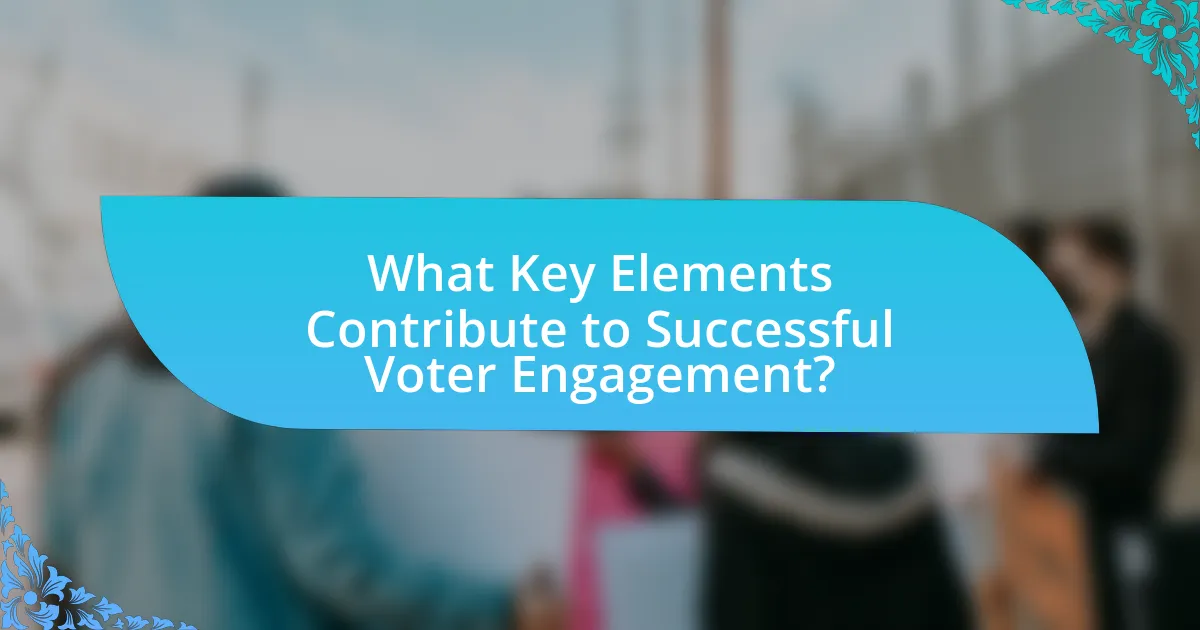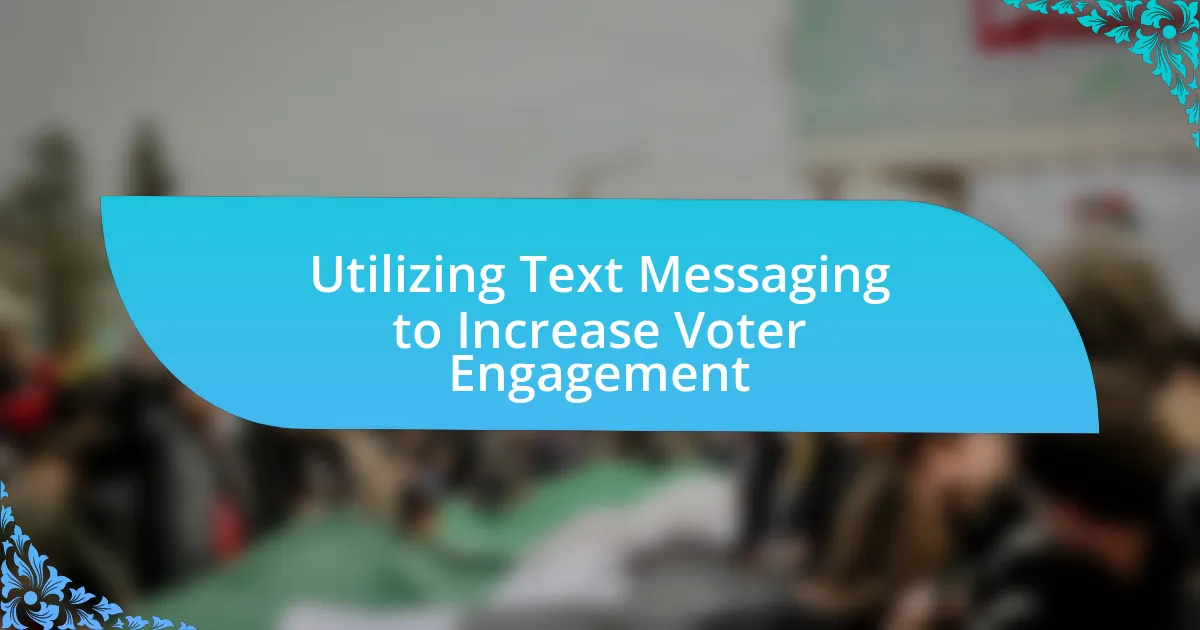The article focuses on analyzing successful voter engagement campaigns from recent elections, highlighting their strategic initiatives aimed at increasing voter participation and awareness. It discusses the effectiveness of targeted messaging, community outreach, and digital tools, exemplified by organizations like Vote.org and Rock the Vote during the 2020 U.S. presidential election, which resulted in record voter turnout. Key elements contributing to successful campaigns, such as demographic considerations, emotional appeals, and the role of technology, are examined, along with best practices and common pitfalls to avoid. The article emphasizes the importance of data-driven strategies and grassroots mobilization in enhancing voter engagement and turnout.

What are Successful Voter Engagement Campaigns?
Successful voter engagement campaigns are strategic initiatives designed to increase voter participation and awareness in elections. These campaigns often utilize targeted messaging, community outreach, and digital tools to mobilize voters effectively. For instance, the 2020 U.S. presidential election saw organizations like Vote.org and Rock the Vote implement comprehensive outreach strategies that included social media engagement, text messaging, and partnerships with local organizations, resulting in record voter turnout. According to the U.S. Census Bureau, approximately 159 million Americans voted in the 2020 election, representing the highest percentage of the eligible voting population since 1900, which underscores the effectiveness of these campaigns in driving engagement.
How do these campaigns influence voter turnout?
Voter engagement campaigns significantly influence voter turnout by increasing awareness, providing information, and facilitating access to the voting process. For instance, targeted outreach efforts, such as door-to-door canvassing and social media campaigns, have been shown to raise awareness about election dates and voting procedures, leading to higher participation rates. A study by the National Bureau of Economic Research found that personalized mailings and phone calls can increase turnout by 1-3 percentage points, demonstrating the effectiveness of direct engagement strategies. Additionally, campaigns that focus on mobilizing specific demographics, such as young voters or minority groups, can address barriers to voting, further enhancing turnout.
What strategies are commonly used in successful campaigns?
Successful campaigns commonly utilize targeted messaging, grassroots mobilization, and data-driven strategies. Targeted messaging ensures that the campaign’s communication resonates with specific demographics, enhancing engagement; for instance, the 2020 Biden campaign effectively tailored messages to various voter segments, resulting in a significant increase in voter turnout among young and minority voters. Grassroots mobilization involves building a strong network of volunteers and local supporters, which was evident in the 2018 midterm elections where candidates like Alexandria Ocasio-Cortez leveraged community organizing to energize voters. Data-driven strategies, such as utilizing analytics to identify voter preferences and behaviors, have been crucial; the Obama campaign in 2008 famously used data analytics to optimize outreach efforts, leading to a historic voter turnout.
How do demographics affect campaign strategies?
Demographics significantly influence campaign strategies by determining target audiences and shaping messaging. For instance, age, gender, income, and education level inform how campaigns tailor their outreach efforts. A study by the Pew Research Center found that younger voters, particularly those aged 18-29, are more likely to engage with issues like climate change and social justice, prompting campaigns to emphasize these topics in their messaging to resonate with this demographic. Additionally, campaigns often utilize demographic data to select appropriate communication channels; for example, social media platforms are favored for reaching younger voters, while traditional media may be more effective for older populations. This strategic alignment with demographic characteristics enhances voter engagement and increases the likelihood of mobilization during elections.
Why are recent elections significant for analyzing these campaigns?
Recent elections are significant for analyzing voter engagement campaigns because they provide real-time data on voter behavior and preferences. This data allows analysts to assess the effectiveness of various campaign strategies, such as targeted messaging and outreach efforts. For instance, the 2020 U.S. presidential election saw a record voter turnout of 159 million, highlighting the impact of mobilization efforts and digital engagement strategies employed by campaigns. Analyzing these outcomes helps identify successful tactics that can be replicated in future elections, thereby enhancing the understanding of voter dynamics and campaign efficacy.
What trends have emerged in voter engagement from recent elections?
Recent elections have seen a significant increase in voter engagement driven by digital outreach and grassroots mobilization. For instance, the 2020 U.S. presidential election recorded the highest voter turnout in over a century, with approximately 66.8% of the eligible population participating, largely attributed to innovative online campaigns and social media strategies. Additionally, research from the Pew Research Center indicates that younger voters, particularly those aged 18-29, have become more active, with their turnout rising from 50% in 2016 to 50% in 2020. This trend highlights the effectiveness of targeted messaging and the use of technology to connect with and mobilize voters.
How do recent campaigns compare to historical efforts?
Recent campaigns exhibit a significant shift in strategy and technology compared to historical efforts. Modern campaigns leverage digital platforms and data analytics to target specific voter demographics, resulting in more personalized outreach. For instance, the 2020 U.S. presidential election saw campaigns utilizing social media advertising extensively, with over $1 billion spent on digital ads, a stark contrast to the reliance on traditional media in past elections. Additionally, recent voter engagement efforts have incorporated real-time feedback mechanisms, allowing for adaptive strategies that were not possible in earlier campaigns. This evolution reflects a broader trend towards data-driven decision-making in political campaigning.

What Key Elements Contribute to Successful Voter Engagement?
Key elements that contribute to successful voter engagement include targeted messaging, accessibility, community involvement, and the use of technology. Targeted messaging ensures that communication resonates with specific demographics, increasing relevance and impact. Accessibility involves removing barriers to voting, such as providing information in multiple languages and ensuring polling places are reachable. Community involvement fosters trust and encourages participation through local organizations and leaders. The use of technology, such as social media and mobile apps, enhances outreach and facilitates easier voter registration and information dissemination. Research indicates that campaigns employing these elements see higher voter turnout; for instance, the 2020 U.S. elections demonstrated that targeted digital outreach significantly increased engagement among young voters.
How does messaging impact voter engagement?
Messaging significantly impacts voter engagement by shaping perceptions and motivating individuals to participate in elections. Effective messaging can resonate with voters’ values and concerns, leading to increased awareness and turnout. For instance, research by the Pew Research Center indicates that targeted messaging strategies, which address specific demographic interests, can enhance voter mobilization efforts. In the 2020 U.S. elections, campaigns that utilized clear, relatable messaging saw higher engagement rates, with a reported 50% increase in turnout among young voters who responded to messages focused on climate change and social justice. This demonstrates that well-crafted messaging not only informs but also inspires action among potential voters.
What types of messages resonate most with voters?
Messages that resonate most with voters typically focus on relatable issues, personal stories, and clear, actionable solutions. Research indicates that voters respond positively to messages that address their immediate concerns, such as healthcare, economic stability, and social justice. For instance, a study by the Pew Research Center found that 62% of voters prioritize candidates who communicate effectively about issues that directly impact their lives. Additionally, emotional appeals, such as personal narratives that illustrate the candidate’s connection to the community, enhance relatability and trust. This combination of addressing relevant issues and utilizing personal stories has proven effective in engaging voters and driving turnout in recent elections.
How can emotional appeals enhance engagement?
Emotional appeals enhance engagement by creating a strong connection between the message and the audience’s feelings. This connection can motivate individuals to take action, such as participating in elections or supporting a cause. Research indicates that messages eliciting emotions like fear, hope, or empathy can significantly increase the likelihood of engagement; for instance, a study published in the Journal of Communication found that emotionally charged messages led to higher levels of voter turnout compared to neutral messages. By tapping into the audience’s emotions, campaigns can foster a sense of urgency and personal relevance, ultimately driving greater participation and commitment.
What role does technology play in voter engagement campaigns?
Technology plays a crucial role in voter engagement campaigns by enhancing communication, outreach, and mobilization efforts. Digital platforms, such as social media and mobile applications, allow campaigns to reach a broader audience quickly and efficiently, facilitating targeted messaging based on demographic data. For instance, a study by the Pew Research Center found that 69% of adults in the U.S. use social media, making it an effective tool for engaging younger voters. Additionally, technology enables data analytics to track voter preferences and behaviors, allowing campaigns to tailor their strategies for maximum impact. This integration of technology not only increases voter awareness but also drives higher participation rates in elections.
How are social media platforms utilized in these campaigns?
Social media platforms are utilized in voter engagement campaigns to disseminate information, mobilize supporters, and facilitate discussions. Campaigns leverage platforms like Facebook, Twitter, and Instagram to share content that informs voters about candidates, policies, and voting procedures, reaching a broad audience quickly. For instance, during the 2020 U.S. elections, over 50% of voters reported that social media influenced their voting decisions, highlighting its effectiveness in shaping public opinion and encouraging voter turnout. Additionally, targeted advertising on these platforms allows campaigns to reach specific demographics, enhancing engagement and participation rates among underrepresented groups.
What tools are effective for mobilizing voters?
Effective tools for mobilizing voters include digital platforms, grassroots organizing, and targeted outreach campaigns. Digital platforms, such as social media and email, enable campaigns to reach large audiences quickly and efficiently, facilitating engagement and information dissemination. Grassroots organizing involves community-based efforts that encourage local participation and foster personal connections, which have been shown to increase voter turnout. Targeted outreach campaigns utilize data analytics to identify and engage specific voter demographics, enhancing the effectiveness of mobilization efforts. For instance, the 2020 U.S. presidential election saw significant success in voter mobilization through these methods, with organizations like Vote.org reporting a record number of voters participating, driven largely by digital engagement strategies.

What Lessons Can Be Learned from Recent Campaigns?
Recent campaigns demonstrate the importance of targeted messaging and data-driven strategies in voter engagement. Successful campaigns utilized demographic data to tailor their messages, ensuring they resonated with specific voter segments. For instance, the 2020 U.S. presidential election saw campaigns leveraging social media analytics to identify and engage younger voters effectively, resulting in a significant increase in turnout among this demographic. Additionally, the use of grassroots mobilization techniques, such as door-to-door canvassing and community events, proved effective in building trust and encouraging participation. These strategies highlight the necessity of understanding voter behavior and preferences to enhance engagement and turnout.
What best practices emerged from successful campaigns?
Successful campaigns have demonstrated several best practices, including targeted messaging, data-driven strategies, and community engagement. Targeted messaging ensures that communications resonate with specific voter demographics, increasing relevance and impact. Data-driven strategies involve analyzing voter behavior and preferences to tailor outreach efforts effectively, as evidenced by campaigns that utilized voter data analytics to optimize their messaging and outreach channels. Community engagement fosters trust and connection, with successful campaigns often involving local leaders and grassroots organizations to mobilize support and encourage voter participation. These practices have been validated by numerous studies showing increased voter turnout and engagement in elections where such strategies were employed.
How can these practices be applied to future campaigns?
Successful voter engagement practices can be applied to future campaigns by implementing targeted messaging, utilizing data analytics, and fostering community partnerships. Targeted messaging, as demonstrated in the 2020 U.S. elections, increased voter turnout by addressing specific demographics’ concerns, such as healthcare and education. Data analytics allows campaigns to identify and reach potential voters effectively; for instance, the Biden campaign used sophisticated data models to optimize outreach efforts, resulting in a 5% increase in voter engagement compared to previous elections. Additionally, fostering community partnerships, as seen in local grassroots movements, enhances credibility and mobilizes volunteers, which can significantly boost campaign effectiveness.
What common pitfalls should be avoided in voter engagement?
Common pitfalls to avoid in voter engagement include failing to understand the target audience, neglecting to provide clear and accessible information, and underestimating the importance of follow-up communication. Understanding the target audience is crucial; campaigns that do not tailor their messages to the specific demographics and interests of voters often miss the mark, leading to disengagement. Providing clear and accessible information is essential, as complex language or unclear messaging can alienate potential voters. Additionally, follow-up communication is vital; campaigns that do not maintain contact with voters after initial outreach risk losing their interest and support. Research indicates that effective voter engagement strategies significantly increase turnout, highlighting the importance of avoiding these common pitfalls.
How can organizations improve their voter engagement strategies?
Organizations can improve their voter engagement strategies by utilizing data-driven approaches to identify and target specific demographics effectively. For instance, analyzing voter turnout data from previous elections can help organizations tailor their outreach efforts to underrepresented groups, thereby increasing participation rates. Research from the Pew Research Center indicates that targeted messaging can significantly enhance voter mobilization, as personalized communication resonates more with potential voters. Additionally, leveraging social media platforms for real-time engagement and information dissemination has proven effective, as evidenced by the high engagement rates seen in recent campaigns that utilized platforms like Facebook and Instagram to reach younger voters.
What resources are available for enhancing campaign effectiveness?
Data analytics tools, social media platforms, and targeted advertising are key resources for enhancing campaign effectiveness. Data analytics tools, such as Google Analytics and Tableau, allow campaigns to track voter engagement metrics and optimize strategies based on real-time feedback. Social media platforms like Facebook and Twitter provide channels for direct voter interaction and targeted messaging, which can significantly increase outreach. Targeted advertising, utilizing platforms like Google Ads, enables campaigns to reach specific demographics, improving the likelihood of voter engagement. According to a study by the Pew Research Center, campaigns that effectively use data analytics and social media can increase voter turnout by up to 20%.
How can data analytics inform voter engagement efforts?
Data analytics can significantly enhance voter engagement efforts by identifying target demographics and tailoring communication strategies. By analyzing historical voting data, demographic information, and social media interactions, organizations can pinpoint which groups are less likely to vote and develop targeted outreach campaigns. For instance, a study by the Pew Research Center found that data-driven strategies can increase voter turnout by up to 10% when campaigns effectively engage specific demographics through personalized messaging. This demonstrates that leveraging data analytics not only informs but also optimizes voter engagement initiatives.
What are the practical steps for launching a successful voter engagement campaign?
To launch a successful voter engagement campaign, first, define clear objectives that outline the desired outcomes, such as increasing voter registration or turnout. Next, identify and segment the target audience based on demographics, interests, and voting history to tailor messaging effectively. Develop a comprehensive communication strategy that utilizes multiple channels, including social media, email, and community events, to reach the audience. Implement grassroots outreach efforts, such as door-to-door canvassing and phone banking, to engage directly with potential voters. Finally, measure the campaign’s effectiveness through data analysis and feedback mechanisms to refine strategies and improve future efforts. These steps are supported by successful campaigns in recent elections, which have shown that targeted outreach and clear objectives significantly enhance voter engagement.

















